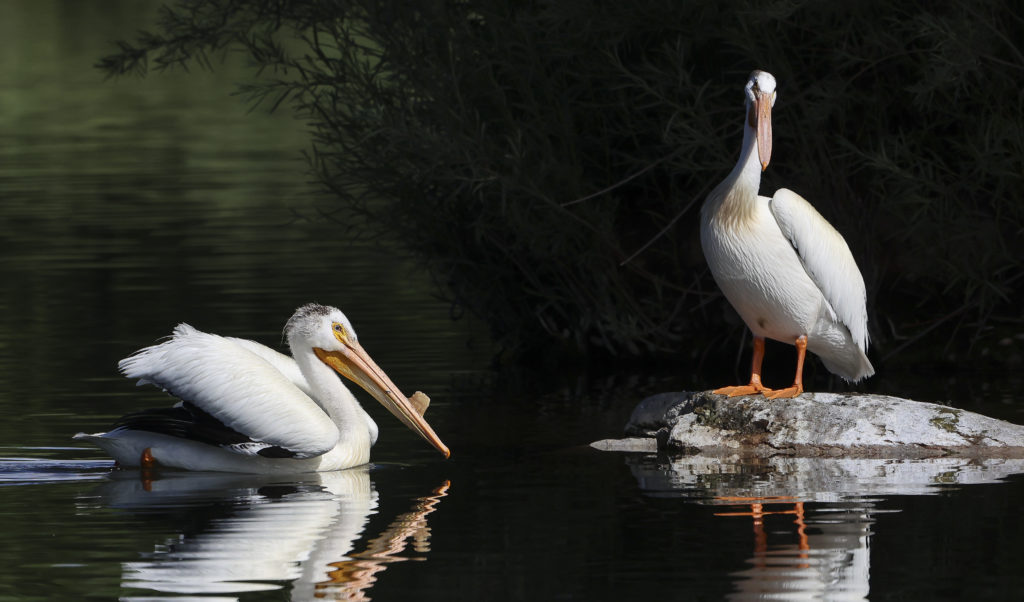The American White Pelican



By Wayne Bierbaum
Several years ago, as I was driving from Maryland to Colorado for a wedding, I took a northern route that took me by the Mississippi River at Rapid City, S.D. I took some time to explore the river and was surprised by the large number of huge white birds swimming at the edge of the river. They were American white pelicans, about 50 of them, doing some collective feeding.
Now I am quite familiar with brown pelicans, which dive beak-first into the water and then swirl their huge pouched beak underwater to catch fish. These birds were bigger and never dove into the water.
Just outside of Denver, I saw several more white pelicans in the area lakes but only in groups of up to eight. Later, that winter, I saw 15 white pelicans at Blackwater National Wildlife Sanctuary on the Eastern Shore.
The American white pelican is an interesting but odd bird. It is likely the heaviest soaring bird in North America, weighing up to 30 pounds and having a wing span over 9 feet—about the same as a California Condor but weighing more. The brown pelican has a 7-foot wingspan.
When the American white pelican is sitting on the water, it appears all white with a pinkish-orange bill. When flying, the black posterior edge of the wing is visible. They have large webbed feet and swim quite well. During breeding season, the top part of a mature bird’s bill will have a large keel on top, which looks like a half slice of an orange. It falls off after the young are hatched.
The white pelican feed by stabbing and then swirling their open pouched bill underwater. Fish, crayfish, amphibians and insects are trapped in the pouch and after the water is siphoned out they raise the bill to swallow the prey. They sometimes will tip their bodies up with their head underwater to swirl their bills deeper in the water. These pelicans, unlike the brown pelican, perform cooperative feeding and herding. They use their bright bodies and swimming ability to herd fish into an ambush area.
The 50 or so birds that I witnessed on the Mississippi River had formed a long line to push schools of fish against the riverbank. They were actively feeding on small fish and when one bird had eaten enough it would back out of the line and another would move in.
The American white pelican is generally a freshwater bird of central and western North America and nests in large groups on gravel or sandy areas. Two eggs are generally laid in a shallow nest but the firstborn chick will almost always kill the second born (siblicide). As the young bird grows to the point of swimming well, it will join with others of the same age to live and yet still be fed by their respective parents.
Cornell Ornithology calls these collections of young birds a creche. The young birds remain in a creche until they can fly. A creche helps the birds with safety and socialization. Few animals would attack a group of snapping and hissing giant birds. Coyotes are pelicans’ primary predators and will steal eggs or occasionally catch one of the large birds in a defenseless position.
During the winter, the pelicans migrate south as far as central South America but many stay in areas of estuaries around the southern US. The white pelicans in Cambridge were over-wintering in the Blackwater River’s estuary. There are areas along the refuge that rarely freeze and evidently fish are there to be caught.
At one time, the future existence of the American white pelican was in doubt when fishermen believed that the birds were responsible for a decline in fish stocks around the U.S. Pelicans were shot in huge numbers. After it was shown that the American white pelican eats mostly what are considered trash fish, the hunting mostly stopped. Recently, a large group of pelicans has been foraging in catfish farm ponds in the South in the winter—and the fish farmers in Mississippi are not happy.
DDT also severely hurt both the brown and white pelican populations, but that damage abated when the chemical was banned.
Their breeding grounds are subject to flooding and since their reproduction rate is low, recovery from environmental catastrophes is slow, taking several years. Yet, the population seems stable.
To see these giant birds in flight, you might have to drive to the Mississippi or visit Blackwater National Wildlife Refuge in the winter and wait on the Wildlife Drive across from the visitor center for hours. You may have to return over and over again because the birds usually sit on a mudflat that is almost a quarter mile away and seem quite content just to stand there. I have only seen them fly twice in 12 years of visiting, but then again, I don’t wait for hours.
